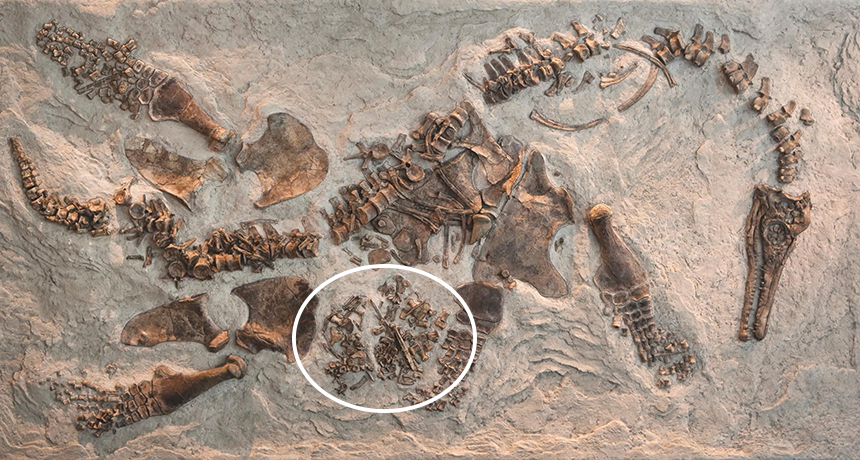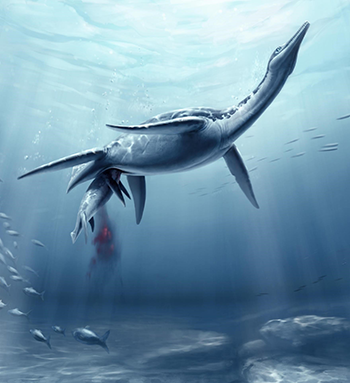Bones show ancient marine reptile was a big baby
Plesiosaurs likely needed this survival advantage in predator-infested seas

The bones of a developing baby (encircled) can be seen inside the skeleton of this plesiosaur.
NHMLA
By Riley Black
Sometimes it’s good to be a big baby. That’s what scientists are learning from a skeleton at the Natural History Museum of Los Angeles, in California. It belongs to a marine reptile known as Polycotylus (Pahl-ee-KOAT-eh-luss). Inside the fossil skeleton, scientists found the bones of a developing baby. By comparing that fossil to other young plesiosaurs, researchers are figuring out how these animals grew.
Polycotylus is a type of plesiosaur (PLEES-ee-oh-sawr). These reptiles swam the seas between 203 million and 66 million years ago. They weren’t dinosaurs, although dinos lived at the same time. Plesiosaurs were enormous — growing to 5 meters (16 feet) in length. We’ve known about they since 1821. That’s when English paleontologist William Conybeare first described one. Back then, no one was sure how these enormous swimmers reproduced.

“We really had no idea,” says Robin O’Keefe. He’s a paleontologist at Marshall University in Huntington, W.V. Today’s sea turtles, also ocean reptiles, lay their eggs on land. No clues existed that plesiosaurs might have had live births. But they seemed too big to venture ashore to lay eggs.
The mystery remained unsolved until 2011. That’s when O’Keefe and his colleagues first studied the Polycotylus skeleton in Los Angeles. As luck would have it, this plesiosaur had been pregnant. That showed scientists that Polycotylus gave birth to live young, instead of laying eggs. And it let O’Keefe compare the baby to other fossils for the new study.
“The fetus of Polycotylus is an extraordinary finding,” says Corinna Fleischle. She’s a paleontologist at the University of Bonn in Germany. Although not involved in this study, she does study plesiosaurs. And she says the discovery “for the first time [makes it possible] to investigate the bone microstructure in an unborn plesiosaur.” That’s what O’Keefe’s team did in its new research.
Boning up on its life history
Scientists had found Polycotylus bones before. Those fossils belonged to reptiles that lived about 75 million years ago. They were found in a seaway that split North America in half. O’Keefe and his colleagues compared these bones to those of the pregnant one. They used a branch of science called histology. It’s the study of microscopic details in body tissues. Such details can point to how these animals grew.
O’Keefe’s team saw one Polycotylus fossil that was similar in size to the unborn baby. This one, however, had already been swimming on its own. The researchers knew that from a line in its bone tissue that likely formed soon after the reptile’s birth. The pressures of having to swim on its own had changed how that baby’s bones were growing.
These data now suggest that a newborn Polycotylus would have been four-tenths its mother’s length. So a baby would have been about 2 meters (7 feet) long at birth. O’Keefe and his colleagues shared their new findings January 2, 2019, in Integrated Organismal Biology.
“Zooming in to the actual bone cells, and seeing the direction of the bone fibers” was very important, O’Keefe says. It helped him to understand how the bones grew. And that revealed more about the ancient reptile’s life story.
Plesiosaurs, the new data show, had “an absolutely unique bone histology,” Fleischle says. It “is not comparable to any other species, living or extinct.” That’s why it’s critical to compare fossil bones to others from the same species, she says.
One big question remains: Why were these creatures born so large?
“We don’t have a lot of hard evidence [to go on],” O’Keefe admits. Still, he has some ideas. Large size and fast growth might have been a form of protection. The reptiles lived during the Mesozoic period, when the “sea was a very dangerous place.” Huge sharks, fish, and other hungry marine reptiles were hunting a meal. In these unfriendly waters, being born big might have helped Polycotylus avoid becoming lunch.







